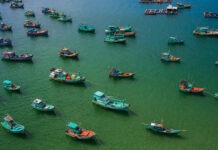Belgium is one of the world’s most fascinating with its historic cities – most famously Brussels, Bruges, Antwerp and Ghent that are the equal of any in Europe. Moreover, its cuisine is reason alone to justify a visit, with a host of wonderful regional specialties. Belgium also boasts some pockets of truly beautiful countryside in its hilly, wooded south and the flatter north – and, perhaps most famously, it produces the most diverse range of beers of any country on the planet. Here are some of the best places to visit in Belgium.

Brussels: Brussels is quickly gaining a reputation as one of Europe’s must-see destinations. Moreover, with its central location in the heart of Europe, it’s easily accessible by air or high-speed rail from neighbouring countries. It is an international metropolis – a mosaic of languages and cultures – and the home of the EU, NATO and myriad organizations.
Brussels is a classic European city with small-town charm and cosmopolitan attractions. Among its most celebrated attractions is La Grand Place, a UNESCO World Heritage Site originally built in the 13thcentury. Arguably, it is Europe’s most beautiful medieval square. If you are a chocoholic make your way to Place du Grand Sablon and its numerous chocolate shops.
Just a short walk from the Grand Place is the Mannekin Pis, a small bronze statue of a little boy relieving himself. The statue, a good example of Belgium’s sense of humor, is given costumes to mark various occasions, anniversaries or events.

Antwerp: Known for its vibrant nightlife, funky bars and restaurants and numerous festivals, Belgians see Antwerp as the ‘capital of cool’. The Antwerp Fashion Academy produced a group of avant-garde designers who made a big splash on the fashion scene in the 1980’s. Consequently, they became known as ‘The Antwerp Six’. Nowadays, the Academy continues to churn out new, hot talent.
If shopping is not your thing, discover the compact center of Antwerp. It juxtaposes beautiful medieval buildings with modern architectural landmarks. You will find plenty historic buildings, as well as the biggest diamond center in the world.
Antwerp is an art-loving city with which the name Rubens is eternally linked. Still, more than 400 years after the birth of this brilliant painter, it is still possible to see the extent to which Rubens left his mark on the city. You can cap your visit off with a taste of the city’s funky nightlife.

Bruges: The historic centre of Bruges, a UNESCO World Heritage Site, is closed to cars, making it easily explored on foot. It’s an impressive city, stunningly beautiful and culturally active, that you can also explore by boat along quiet canals. Actually, you can do it well also by horse-drawn carriage.
Although Bruges is small, it is filled to the brim with architectural and artistic treasures, folklore, chocolate shops and lace boutiques. Moreover, there is no lack of fine restaurants.
One popular place in the city is The Beguinages, a UNESCO World Heritage site. It is the home of the nuns of the order of Saint Benedict. Another is the Halve Maan Brewery, a family-owned brewery, and creator of the famous ‘Brugse Zot’ beer. If you are on a budget buy the discount Bruges City Card or tour the countryside outside the city by bicycle.

Ghent: Belgium’s third largest city is best explored by foot. Of course, there’s also the possibility of bicycles, or by boat along its elegant canals.
Ghent is an unassuming, un-touristy city filled with university students, linger-as-long-as-you-like cafes and well-priced restaurants. It is a city with great mustard, and the ten-day Ghent Celebrations. The latter is held every July and the city goes all out with theatre performances, concerts, singing, dancing, and drinking.
Ghent boasts boasts an Opera House, 18 museums, 100 churches and over 400 historical buildings. The most visited site in Ghent is the famous and beautiful polyptych, the Adoration of the Mystic Lamb painted by the brothers Jan and Hubert van Eyck in 1432.

Liege: Liege, the largest French-speaking city in Belgium after Brussels, is a historical city situated along the Meuse River.
Dating back to Charlemagne, Liege is a treasure trove of historical sites and celebrated collections. Sitting on the Meuse River is the Grand Curtius, home to the prestigious archaeology, decorative arts, religious and Mosan art museums, a glass museum as well as the famous weaponry museum.
Walk up the Coteaux, a winding path of steps and courtyards leading up to the citadel of Liege, and enjoy an incredible view. Just outside the city, visitors have easy access to the Blegny mines and the Henri Chapelle American Military Cemetery, the largest in Belgium.

Namur: Namur, just 1-hour by car or train from Brussels, is the capital of Belgium’s French-speaking region. Sitting on the bank of the Meuse River, this impressive fortified town is surrounded by one of Europe’s largest ancient citadels, first built during the 3rd and 4th centuries, and later reconstructed during the 13th and 14th.
Just outside Namur, the towns of Dinant and Wepion offer wonderful day trips. During the summer months, Wepion produces juicy and flavourful strawberries and strawberry stands from local farmers line the streets selling the fresh fruit.
Further down the road is Dinant, sandwiched between the Meuse River and its citadel, originally built in 1051. You can spend a day visiting the waterfalls of the Grotto of Dinant or the Sanctuary of Beauraing, then grab a table at one of the local cafés while taking in the views of the river.

















